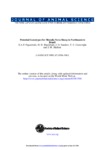Please use this identifier to cite or link to this item:
http://www.alice.cnptia.embrapa.br/alice/handle/doc/514173Full metadata record
| DC Field | Value | Language |
|---|---|---|
| dc.contributor.author | FIGUEIREDO, E. A. P. | pt_BR |
| dc.contributor.author | BLACKBURN, H. D. | pt_BR |
| dc.contributor.author | SANDERS, J. O. | pt_BR |
| dc.contributor.author | CARTWRIGHE, T. C. | pt_BR |
| dc.contributor.author | SHELTON, J. M. | pt_BR |
| dc.date.accessioned | 2011-04-10T11:11:11Z | pt_BR |
| dc.date.available | 2011-04-10T11:11:11Z | pt_BR |
| dc.date.created | 1992-08-01 | pt_BR |
| dc.date.issued | 1989 | pt_BR |
| dc.identifier.citation | Journal of Animal Science, v. 67, n. 8, p. 1956-1963, 1989. | pt_BR |
| dc.identifier.uri | http://www.alice.cnptia.embrapa.br/alice/handle/doc/514173 | pt_BR |
| dc.description | Abstract: A total of 27 combinations of genetic potentials of ewes for mature size (WMA; 30, 40 and 50 kg of body weight), milk production (GMLKL; 1.125, 1.500, and 1.875 kg of milk/ day at the peak day of lactation) and ovulation rate (OVR; 1.65, 2.20, 2.75 ova per ovulation) were simulated. The current genotype was assumed to be 40 WMA, 1.15 GMLKL and 2.20VR. Results showed that annual efficiency of meat production for flocks in northeastern Brazil (total live weight sold: total weight of dry matter consumed) increased when genetic potentials for OVR and GMLKL were raised from base, but decreased with increased genetic potential for mature size. The most efficient genotype was a 40 WMA, 1.50 GMLKL and 2.75 OVR, followed closely by the genotypes 40 WMA, 1.125 GMLKL and 2.75 OVR, and 30 WMA, 1.5 GMLKL and 2.75 OVR. Genotypes with 50 WMA were not present in the 11 genotypes ranked above the base genotype. | pt_BR |
| dc.language.iso | eng | eng |
| dc.rights | openAccess | eng |
| dc.subject | Otimização | pt_BR |
| dc.subject | Optimization | pt_BR |
| dc.subject | Genetic constitution | pt_BR |
| dc.subject | Raça Morada Nova | pt_BR |
| dc.subject | Native species | pt_BR |
| dc.subject | Brasil | pt_BR |
| dc.subject | Animal genetic | pt_BR |
| dc.subject | Genotypes | pt_BR |
| dc.subject | Simulation | pt_BR |
| dc.title | Potential genotypes for Morada Nova sheep in northeastern Brazil. | pt_BR |
| dc.type | Artigo de periódico | pt_BR |
| dc.date.updated | 2015-11-04T11:11:11Z | pt_BR |
| dc.subject.thesagro | Ovino | pt_BR |
| dc.subject.thesagro | Genética animal | pt_BR |
| dc.subject.thesagro | Genótipo | pt_BR |
| dc.subject.thesagro | Simulação | pt_BR |
| dc.subject.thesagro | Espécie nativa | pt_BR |
| dc.subject.nalthesaurus | Sheep | pt_BR |
| dc.subject.nalthesaurus | Brazil | pt_BR |
| riaa.ainfo.id | 514173 | pt_BR |
| riaa.ainfo.lastupdate | 2015-11-04 | pt_BR |
| dc.contributor.institution | Élsio Antônio Pereira Figueiredo, CNPC; Texas A&M Univ. Agric. Res. and Ext. Center at San Angelo; Texas A&M Univ. Agric. Res. and Ext. Center at San Angelo; Texas A&M Univ. Agric. Res. and Ext. Center at San Angelo; Texas A&M Univ. Agric. Res. and Ext. Center at San Angelo. | pt_BR |
| Appears in Collections: | Artigo em periódico indexado (CNPC)  | |
Files in This Item:
| File | Description | Size | Format | |
|---|---|---|---|---|
| apPotential.pdf | 681,48 kB | Adobe PDF |  View/Open |









